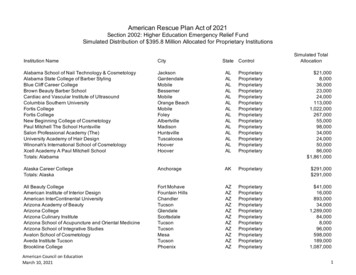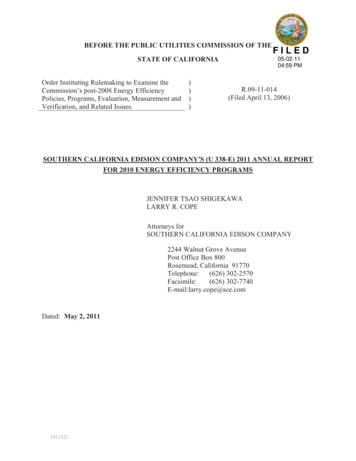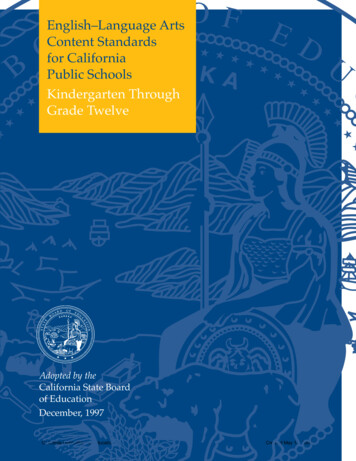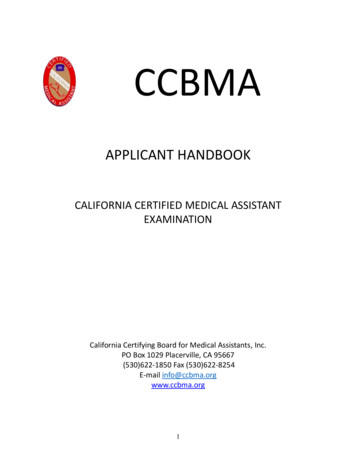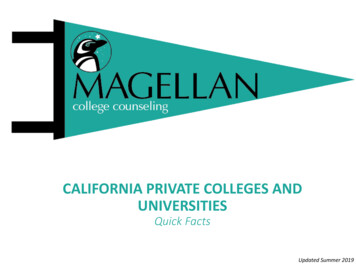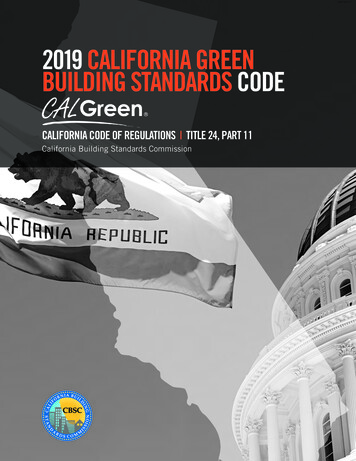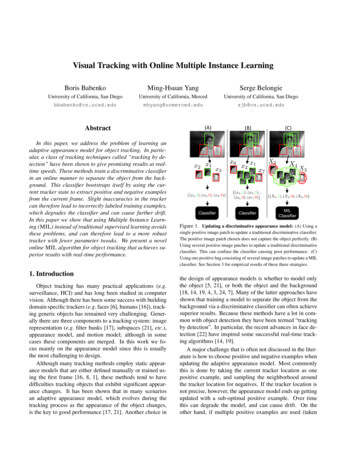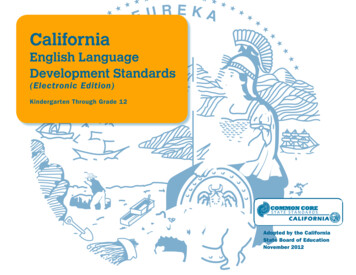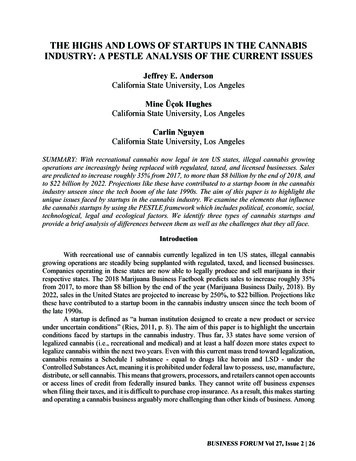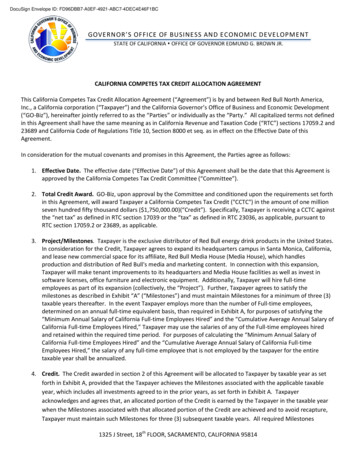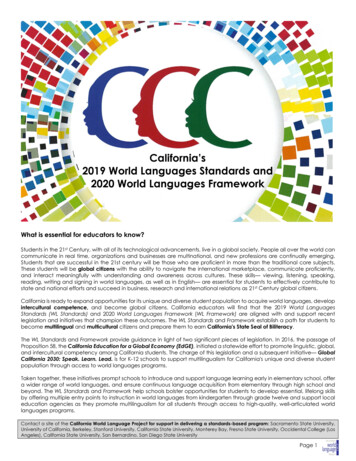
Transcription
California’s2019 World Languages Standards and2020 World Languages FrameworkWhat is essential for educators to know?Students in the 21st Century, with all of its technological advancements, live in a global society. People all over the world cancommunicate in real time, organizations and businesses are multinational, and new professions are continually emerging.Students that are successful in the 21st century will be those who are proficient in more than the traditional core subjects.These students will be global citizens with the ability to navigate the international marketplace, communicate proficiently,and interact meaningfully with understanding and awareness across cultures. These skills— viewing, listening, speaking,reading, writing and signing in world languages, as well as in English— are essential for students to effectively contribute tostate and national efforts and succeed in business, research and international relations as 21st Century global citizens.California is ready to expand opportunities for its unique and diverse student population to acquire world languages, developintercultural competence, and become global citizens. California educators will find that the 2019 World LanguagesStandards (WL Standards) and 2020 World Languages Framework (WL Framework) are aligned with and support recentlegislation and initiatives that champion these outcomes. The WL Standards and Framework establish a path for students tobecome multilingual and multicultural citizens and prepare them to earn California's State Seal of Biliteracy.The WL Standards and Framework provide guidance in light of two significant pieces of legislation. In 2016, the passage ofProposition 58, the California Education for a Global Economy (EdGE), initiated a statewide effort to promote linguistic, global,and intercultural competency among California students. The charge of this legislation and a subsequent initiative— GlobalCalifornia 2030: Speak. Learn. Lead. is for K-12 schools to support multilingualism for California's unique and diverse studentpopulation through access to world languages programs.Taken together, these initiatives prompt schools to introduce and support language learning early in elementary school, offera wider range of world languages, and ensure continuous language acquisition from elementary through high school andbeyond. The WL Standards and Framework help schools bolster opportunities for students to develop essential, lifelong skillsby offering multiple entry points to instruction in world languages from kindergarten through grade twelve and support localeducation agencies as they promote multilingualism for all students through access to high-quality, well-articulated worldlanguages programs.Contact a site of the California World Language Project for support in delivering a standards-based program: Sacramento State University,University of California, Berkeley, Stanford University, California State University, Monterey Bay, Fresno State University, Occidental College (LosAngeles), California State University, San Bernardino, San Diego State UniversityPage 1
Communication takes place in a variety of authentic settingsthat represent what students will experience in the targetcultures. Interpretive: listening, viewing, and reading take place usingknowledge of cultural products, practices, and perspectives. Interpersonal: culturally appropriate listening and speaking,reading and writing, and viewing and signing (American SignLanguage [ASL]) take place as a shared activity amonglanguage users. Presentational: speaking, signing, and writing take place foran audience of listeners, readers, and viewers in culturallyappropriate ways.The Communication Standards use the term structures tocapture the multiple components of grammar that studentsmust learn to communicate with accuracy. Further, they embedthe Communities “settings” and Language Comparisonsstandards of the American Council on the Teaching of ForeignLanguage’s (ACTFL) 5 Cs to highlight their function in servicePageof1communication.Students must acquire the ability to interact appropriately withculture bearers to communicate successfully. Culturallyappropriate language use requires an understanding of therelationships between the products and practices of culturesand their underlying perspectives. While acquiring knowledgeof products, practices, and perspectives of the target cultures,learners engage in comparisons of similarities and differencesamong their cultures and the target cultures, and exploreintercultural influences when they come into contact withmultilingual and multicultural communities.Language users address a variety of topics that are appropriateto their age and range of proficiency, increase their knowledgeof numerous areas of the curriculum, and make connectionsacross K-12 areas of study. As students develop their ability tocommunicate in the target language and cultures, they areable to more fully address topics that increase in complexity andlearn how target-culture bearers understand and addressdiscipline-specific and cross-disciplinary concepts.cultural comparisons - Students use the targetlanguage to investigate, explain, and reflecton the nature of culture through comparisonsof similarities and differences among thetarget cultures and those they know in orderto interact with cultural competence.cultural perspectives - Beliefs of members of aparticular group.cultural practices - Behaviors of members of aparticular group.cultural products - Tangible and intangibleitems created and used by members of aparticular group.culture bearers - Individuals in a group whoshare common behaviors and views of theworld.intercultural influences - How diverse culturalgroups affect one another's on.interpersonal communication - Languageusers listen and speak, read and write, andview and sign as they negotiate meaning withothers.interpretive communication - Language userslisten to, read, and view authentic materialsusing knowledge of cultural products,practices, and perspectives without theopportunity for interpersonal communication.presentational communication - Languageusers speak, sign, and write in culturallyappropriate ways for audiences of listenersviewers and readers without the opportunityto negotiate meaning.settings - Situations in which the language isused (highly predictable, transactional,informal, formal); may be face-to-face ormediated by technology.structures - Elements of the linguistic system(phonology/parameters in ASL, morphology,syntax).Communities and Language Comparisons Curricular Areas are Integratedinto the Communication StandardsCalifornia’s WL Standards and Framework incorporate the five goals, also known as the 5 Cs of ACTFL’s standards, into threecurricular strands— Communication, Cultures, and Connections. Educators familiar with ACTFL’s standards will recognize whatthis redistribution accomplishes: As a result of integrating the Communities goal into California’s Communication strand,California’s WL Standards and Framework emphasize the communicative importance of the settings where learners need tointeract in target-language communities at home and around the world. Now that the Language Comparisons goal is partof the Communication strand, the Communication standards emphasize how students use receptive and productivestructures and language comparisons in service of communication. While the approach to teaching and learning worldlanguages remains aligned with ACTFL’s standards, the Communities and Language Comparisons goals have beendistributed strategically in California’s WL Standards and Framework in order to emphasize real-world communication in theworld languages classroom.Page 2
Communication, Cultures, Connections(N)ovice, (I)ntermediate, (A)dvanced, (S)uperiorThe goals of the standards are aligned with themost current documents that inform languageand culture education1 and highlight how theysupport Global California 2030 by identifyingwhat students should know and be able to do inlanguages other than English. They establish apath for students to become multilingual andmulticultural citizens and prepare themselves toearn California's State Seal of Biliteracy.Communication Standard 7Goal: to interact with communicative competence, studentsuse the target language to investigate, explain, and reflect onthe nature of language through comparisons of similarities anddifferences among the target language and in the language(s)they know. Title of the standard— “Communication Standard 7:Language Comparisons in Service of Communication.” Thegoal(s) of the standard are placed under the title, followed by achart describing student outcomes within different ranges ofproficiency, e.g., WL (World Language), CM (Communication) 7(Standard 7) I (Intermediate Range).Communication GoalsNoviceIntermediateAdvancedInterpretive ssinformation,studentsdemonstrate understanding, interpret and analyzewhat is heard, read, or viewed on a variety of topicsfrom authentic texts, using technology whenappropriate.Identify similarities anddifferences in theorthography,phonology, ASLparameters and verybasic sentence-levelPage 1elements(morphology and/orsyntax) of thelanguages known.Identify similarities anddifferences in thebasic sentence-levelelements(morphology andsyntax) of thelanguages known.Identify similarities anddifferences insentence-levelelements(morphology andsyntax in major timeframes) and inparagraph-leveldiscourse (textstructure) of thelanguages known.Interpersonal CommunicationWL.CM2: To collaborate, share information,reactions, feelings, and opinions, students negotiatemeaning in a variety of real-world settings and formultiple purposes, in spoken, signed (ASL), or writtenconversations, using technology as appropriate.Presentational CommunicationCultures GoalsWL.CM3: To present and publish, students presentinformation on a variety of topics for multiplepurposes, in culturally appropriate ways, adaptingto various audiences of listeners, readers, or viewers,using the most suitable media and technologies.Culturally Appropriate InteractionSettings for CommunicationWL.CM4: Students use language in highlypredictable, daily settings (N); transactional andsome informal settings (I); most informal and formalsettings (A); or informal, formal, and professionalsettings, and unfamiliar and problem situations (S) intheir communities and in the globalized world. Theyrecognize (N), participate in (I), initiate (A), or sustain(S) language-use opportunities outside classroomsand set goals, reflect on progress, and use languagefor enjoyment, enrichment, and advancement.Structures in Service of CommunicationWL.CM5, 6: Students use structures to communicate:sounds, parameters (ASL) writing systems (N); basicword and sentence formation (I); structures for majortime frames, text structures for paragraph-leveldiscourse (A); or all structures, and text structures forextended discourse (S). They use language texttypes to communicate: learned words, signs,fingerspelling (ASL) and phrases (N); sentences andstrings of sentences (I); paragraphs and strings ofparagraphs (A); or coherent, cohesive multiparagraph texts (S).WL.CL1: Students interact with cultural competence and understanding.Cultural Products, Practices and PerspectivesWL.CL2: To interact with cultural competence, students demonstrateunderstanding and use the target language to investigate, explain, andreflect on the relationships among the products cultures produce, thepractices cultures manifest, and the perspectives that underlie them.Cultural ComparisonsWL.CL3: To interact with cultural competence, students use the targetlanguage to investigate, explain, and reflect on the nature of culturethrough comparisons of similarities and differences among the targetculture(s) and the culture(s) they know.Intercultural InfluencesWL.CL4: To interact with intercultural competence, students demonstrateunderstanding and use the target language to investigate how culturesinfluence one another over time.Connections GoalsConnections to Other DisciplinesWL.CN1: To function in real-world situations in academic and careerrelated settings, students build, reinforce, and expand their knowledge ofother disciplines using the target language to develop critical thinkingand solve problems.Comparisons in Service of CommunicationDiverse Perspectives and Distinctive ence, students use the target language toinvestigate, explain, and reflect on the nature oflanguage through comparisons of similarities anddifferences among the target language and thelanguage(s) they know.WL.CN:2 To function in real-world situations in academic and careerrelated settings, students access and evaluate information and diverseperspectives that are readily or only available through the language andits cultures.Page 3
1 Shiftsin Instructional Approaches in the World Languages Standards and FrameworkThe WL Standards and Framework illustrate necessary shifts in instructional approaches intended to bring about optimalperformance among students in world languages classrooms. The standards and framework, and specifically the Thenand Now chart highlighted in the appendix of the standards document, "Ways Students May Access the World LanguagesStandards”2 respond to a call to action to create a more effective learning environment in the world languages classroom.The Then and Now chart calls attention to necessary shifts in instructional approaches by contrasting the practices of thepast (Then) with practices supported by current research that yield evidence of positive impact on world languagesacquisition (Now). Characterization of teacher practice does not typically reflect “then” or “now” but rather can beplaced on a continuum distinguished by always, frequently, sometimes, seldom or never. Additional guidance for programdelivery is provided in the appendices of the WL Standards and is fully developed in California’s 2020 World LanguagesFramework.1. Then - Students learn about the target languageNow - Students learn to use the target language Teachers use the target language almost exclusively. Teachers use the target language to make language,culture, and content comprehensible using multiplemodalities for learning. Grammar is taught as a tool for communication.2. Then - Teacher-centered classNow - Student-centered with teacher as facilitatoror collaborator Teachers design activities that lead to autonomy andflexibility in unrehearsed situations and create astudent-driven class. Students engage in individual, pair, and small- andwhole-group activities. Students are able to choose activities based on learningprofiles, readiness, and interests. Students are able to assess, plan, and direct their ownlearning.3. Then - Focus on four skills in the target languageNow - Focus on interpersonal, interpretive, andpresentational communication in thetarget language Students interpret authentic (informative, cultural,literary) audio, video, written and signed texts. Students communicate spontaneously in culturallyauthentic, real-world settings. Students make a variety of presentations for targetculture audiences in culturally-appropriate ways.4. Then - Coverage of the textbookNow - Use of backward design focusing onthe end goal Teachers design culturally-authentic integratedperformance tasks for units and courses in the targetlanguage. Performance tasks develop skills measured inbenchmarks and final examinations. Assessment (contextualized form checks, measures,integrated performance tasks) inform instruction.5. Then - Use of the textbook as the curriculumNow - Use of thematic units and authentic resources Essential questions and enduring understandings andskills guide the selection of themes and sub-themes. Teachers use authentic materials rich in language,culture, and content. Materials from the textbook are used only when thosematerials develop appropriate knowledge and skills.6. Then - Emphasis on teacher as presenterNow - Emphasis on student as "doer" and "creator" Students use the target language for real-world purposesin culturally appropriate ways. Students use the target language beyond the classroom. Students use the target language to learn content, thinkcritically, and solve problems.7. Then - Focus on isolated cultural "factoids"Now - Focus on relationships among culturalproducts, practices, and perspectives Students learn and use the target cultures through thetarget language. Students learn to function in culturally appropriate ways. Students learn target-culture perspectives that underliecultural products and practices. Students recognize and understand the effects ofintercultural influences.8. Then - Use of technology as a "cool tool"Now - Integration of technology into instruction toenhance learning Teachers use technology to locate and teach authentictexts rich in language, culture, and content. Students use technology to access and select content,research, collaborate, cite evidence, revise, edit, andpublish in the target language. Students use technology to communicate in the targetlanguage, supported with digital media and visualdisplays.9. Then - Teach only the languageNow - Use of language as the vehicle to teachacademic content Students further their knowledge of content through theuse of the target language and its resources. Students learn target-culture perspectives on content. Students develop Information, Media, Technology, andEmotional literacies.10. Then - Same instruction for all studentsNow - Differentiated instruction to meetindividual needs Teachers differentiate based on student learning profiles,readiness, and interests. Teachers differentiate content, process, and products. Teachers differentiate for students who are disengagedor accelerated, who have disabilities or other specialneeds, and who are heritage and native speakers.Page 4
11. Then - Use of situations from textbookNow - Use of personalized real-world tasks Students use the target language in real-world settings. Students use the target language spontaneously. Students exchange information and opinions andexpress thoughts and feelings through the targetlanguage.12. Then - Classroom language teachingNow - Opportunities to use the language beyondthe classroom Students participate in language-use opportunities withtarget-language users in the school. Students participate in target-language-useopportunities in local and global communities. Students show evidence of becoming life-long learners.13. Then - Test to find out what students don’t knowNow - Assess to find out what students can do Teachers use measures to generate a profile of studentstrengths and weaknesses in the target language. Teachers design tasks that require proficiency intarget language communication, cultures and content. Teachers differentiate content, process, and productsto optimize opportunities for success14. Then - Teacher knows criteria for gradingNow - Students understand criteria for assessmentand use rubrics Teachers use criteria and rubrics that focus ontarget language communication, culture, and content. Students participate in self-assessment using teacher,class and self-generated criteria and rubrics. Students self-direct when demonstrating knowledgeand proficiency.15. Then - Students "turn in" work for the teacherNow - Students create to "share and publish" fortarget-culture audiences Students interpret a wide variety of authentic materials. Students communicate interpersonally in real-worldsituations. Students present to target-culture audiences for avariety of purposes and in appropriate ways.Ways the World Languages Standards and FrameworkSupport Biliteracy and Multilingual EducationThe study of world languages and cultures provides a windowinto how others understand and act in the world as well asopportunities to value differences, as learners becomemultilingual and multicultural. California’s State Seal of Biliteracyrecognizes high school graduates who have attained highlevels of proficiency in one or more languages in addition toEnglish. High levels of literacy require long sequences of worldlanguages and culture study, diagnostic and placementexaminations for multiple entry and exit points throughout theK-12 sequence, and the development of a variety of coursesthat support advanced and even superior levels of proficiency.In light of the potential for increase of multilingual educationprograms in elementary schools, secondary programs need tofocus their efforts on the development of advanced courses inlanguage arts in the target language beyond those theycurrently offer. With attention placed on culturally-appropriateperspectives on content, courses from the core curriculumneed to be taught using perspectives from the target cultures.Schools also need to encourage students at advanced levelsin English and an additional language to begin the study of athird and fourth world language.Ways the World Languages Standards and FrameworkSupport the Common Core State Standards3Unlike the Common Core State Standards (CCSS), California’sWorld Languages Standards and Framework (WLS/F) aredesigned to be delivered in a language other than English. TheWLS/F do support the CCSS through transfer of knowledge andskills, constrained of course, by students’ range of proficiency inthe target language. The outcomes that follow identify ways inwhich, within all ranges of target language proficiency, theWLS/F can be used to strengthen achievement in the CCSS.Reading1. Key Ideas and DetailsWL.R.1 Read for main ideas.2. Craft and StructureWL.R.2 Read for supporting details.3. Integration of Knowledge and IdeasWL.R.3 Use knowledge and ideas from reading in speaking,signing (ASL) and writing.4. Range of Reading and Level of Text ComplexityWL.R.4 Read informational, cultural and literary texts.Writing1. Text Types and PurposesWL.W.1 Write for a variety of purposes and audiences.2. Production and Distribution of WritingWL.W.2 Write, revise, edit and rewrite.3. Research to Build and Present KnowledgeWL.W.3 Use technology to research, produce and publishand to collaborate with others.4. Range of WritingWL.W.4 Write a variety of texts.Speaking and Listening (Signing and Viewing)1. Comprehension and CollaborationWL.SL.1 Converse and collaborate with others.2. Presentation of Knowledge and IdeasWL.SL.2 Present knowledge in speech or sign (ASL)supported by digital media and visual displays.Language1. Conventions of Standard LanguageWL.L.1 Use conventions of the standard target language inspeaking or signing and writing.2. Knowledge of LanguageWL.L.2 Recognize effect of choice on meaning and chooselanguage appropriate to register.3. Vocabulary Acquisition and UseWL.L.3 Develop receptive and productive vocabularies.This document was derived from the 2019 World LanguagesStandards and 2020 World Languages Framework, materialsproduced by the California Department of Education as well asfrom the following sources:1. The goal statements were adapted from the World ReadinessStandards for Learning Languages (ACTFL, 2015) and from“Outcomes for Language and Culture Learning” (Zaslow,2016), California World Language Project2. Then and Now was expanded by Zaslow (2011) using the 21stCentury Skills Map for World Languages, (ACTFL, 2011)3. From Zaslow (2013) “Reasonable Common Core Outcomesfor World Language and Culture Education”, California WorldLanguage ProjectPage 5
The Length of Time for Learning Languages and CulturesUniversal Design for Learning and DifferentiationThe amount of time it takes to learn another language and itscultures is linked to the linguistic and cultural differences amongthe languages and cultures students know. The particularlanguage and cultures that learners study and theirperformance profile when they enter a program determine theamount of time required to achieve a particular level ofproficiency. Categories of languages have been established bythe federal government based on the time it takes for nativespeakers of English to develop proficiency in target languagesand cultures. For students who speak English only, Arabic,Japanese, Korean and Mandarin, Category IV languages, willtake considerably longer to acquire than French, Italian,Portuguese or Spanish , Category I languages. For students whospeak Hebrew, in addition to English, acquiring Arabic will takesubstantially less time, due to the similarities between these twoSemitic languages. American Sign Language (ASL), ClassicalGreek, Latin, and Native American languages have not beenassigned to language categories although data does exist ontimes required to attain particular levels of proficiency.Universal Design for Learning provides students with a widerange of abilities, special needs, ethnic backgrounds,language skills, and learning styles multiple means ofrepresentation, action, expression, and engagement. It is a setof principles for curriculum development that gives all studentsequal opportunities to learn. It focuses on the “what” oflearning, content; the “how” of learning, process and products;and the “why” of learning, interest and motivation.Category I: Languages closely related to EnglishDanish, Dutch, French, Italian,Romanian, Spanish, SwedishNorwegian,Portuguese,Category II: Languages with linguistic and/or culturaldifferences from EnglishGerman, Hatian Creole, Indonesian, Malay, SwahiliCategory III: Languages with significant linguistic and/orcultural differences from English (This list is not exhaustive)Armenian, Bengali, Bulgarian, Burmese, Czech, Dari, Farsi,Filipino, Finnish, Greek Hebrew, Hindi, Hmong, *Hungarian,Khmer, Lao, Pashto, Polish, Punjabi, Russian, Serbian, Tamil, *Thai,Turkish, Urdu, *Vietnamese, Xhosa, ZuluLanguages preceded by asterisks typically take more time for nativeEnglish speakers to learn than other languages in the same category.Category IV: Languages with the most significantlinguistic and/or cultural differences from EnglishArabic, Cantonese, Mandarin, *Japanese, KoreanRanges and Phases of ProficiencyThe ranges and phases of proficiency referenced in this sectionare derived from those created by the American Council on theTeaching of Foreign Languages and have been adapted fromthe assessment manuals developed by the California WorldLanguage Project, the Classroom Oral Competency Interview,the Classroom Writing Competency Assessment and theClassroom Receptive Competency Matrix.Novice Range (Formulaic language)Learners use learned words and phrases [text-types].Intermediate Range (Created language)Learners use sentences and strings of sentences [text-types].Advanced Range (Planned language)Learners use paragraphs and strings of paragraphs [text-types].Superior Range (Extended language)Learners use coherent and cohesive multi-paragraph texts.Low PhaseLearners are just able to produce the text-type characteristic ofthe range. Accuracy in comprehension and production is low.Mid PhaseLearners produce a wide variety of text-types within the range.Accuracy in comprehension and production is high.High PhaseLearners begin to produce, but not consistently, text-types of thesubsequent range. Accuracy in comprehension and productionis maintained in the current range of proficiency and is low inthe subsequent range.A differentiated classroom serves the needs of all studentsincluding those with disabilities. In a differentiated classroom,the teacher plans and carries out varied approaches tocontent, process, and products in anticipation of and responseto student differences in readiness, interest, and learningneeds. Differentiated instruction provides multiple approachesto content, process, and products. The aim is to create alearning environment which encourages students to engagetheir abilities to the greatest extent possible, including takingrisks and building knowledge and skills in what studentsperceive as a safe, flexible environment. It is a blend of wholeclass, group, and individual instruction. It is student-centered,fosters independence and initiative, is interdisciplinary, open,encouraging, complex, rich in resources, methods, and tasks,mobile, flexible and fluid, qualitative, proactive and adapting.Differentiating Curricular Elements of ContentContent refers to knowledge and skill. It is what students mustknow and be able to do as the result of instruction. Contentmay be differentiated by focusing on the unit’s most relevantand essential elements. Process refers to the ways studentsinteract with content during the phases of the unit. Process isthe “how” of teaching. To modify process, teachers can applya variety of strategies such as grouping by ability, interest, orlearning profile, e.g., strengths and weaknesses. Products arethe ways in which students demonstrate their knowledge andskills. Both Bloom’s Taxonomy and Gardner’s Framework forMultiple Intelligences can be applied to the differentiation ofproducts, providing greater challenge and variety in howstudents show what they know and can do.Differentiating for Student TraitsStudents learn better when their interests, learning profiles andreadiness level have been recognized. In order to respond tolearners’ diverse interests, teachers can align the keyunderstandings of the unit with topics that intrigue students,encourage investigation, and give choices of products ortasks, including student-designed options. A number ofvariables comprise a student’s learning profile including thedesire to work alone or in groups, preferring hands-on activitiesover logical-sequencing activities, learning better whenlistening over viewing, and demonstrating a strong musicalrhythmic over bodily-kinesthetic intelligence. Teachers canaddress these variables and create positive learningenvironments with flexible learning options: a choice ofcooperative,independent,orco
reading and writing, and viewing and signing (American Sign Language [ASL]) take place as a shared activity among language users. Presentational: speaking, signing, and writing take place for an audience of listen
